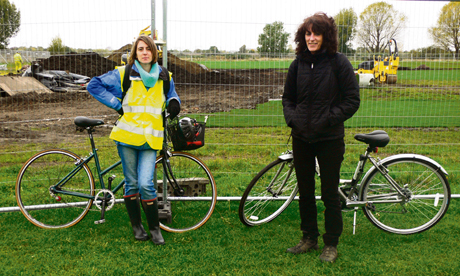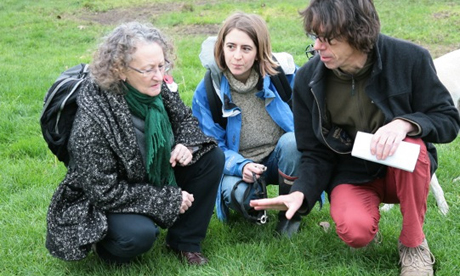Campaigners fear post-Olympic ‘toxic’ legacy on Leyton Marshes

Concerned: Caroline Day and Vicky Sholund of campaign group Save Leyton Marsh. Photograph: Aoife Moriarty
Since London won in its Olympic bid back in 2005, there has rarely been mention of the world’s biggest sporting event without mention of the word ‘legacy’.
But many residents of Hackney and Waltham Forest failed to see exactly what kind of legacy they would benefit from in the construction of a private basketball training facility on the greenbelt land of Leyton Marsh.
The venue was used by both Olympic and Paralympic athletes as part of their preparations for competing in London 2012.
Now, eight months later, they are still waiting for the return of Porter’s Field, and concerns have developed over the environmental impact of the construction work.
Back in July 2011, The Lee Valley Regional Park Authority (LVRPA), responsible for managing the Lea Valley, finalised a license agreement with the Olympic Delivery Authority (ODA) for use of Leyton Marsh on a temporary basis from April to October this year.
However, it was not until mid December last year that residents first started hearing murmurs about the plans.
Caroline Day, a member of the Save Leyton Marsh campaign group, was “horrified” when she spotted planning notices whilst walking her dog on 28 December.
“I just thought, ‘Why have they chosen here?’ I mean at that point, it’s just incredulity, you think, ’No, this can’t happen, this has got to be rejected’.”
But despite opposition from over 80 local people at a Waltham Forest Council planning meeting in February, the construction was granted permission on the basis that the Olympics created “exceptional circumstances”.
A standoff between the Save Leyton Marsh group and the authorities followed, culminating in the setting up of a protest camp in March with the help of Occupy London.
The camp blocked incoming lorries and stopped the delivery of construction materials to the site for over two weeks.
“There was amazing solidarity between the camp and local community and we had a feeling that we were going to win,” Ms Day explained.
“We knew it was unlikely, but we stopped work for two weeks. No work had taken place on site, the camp was there – it was not a huge camp but the atmosphere was very good.”
Tensions reached breaking point when the camp was served with an injunction in April and evicted the following week, with four arrests being made under the Public Order Act.
Work then went ahead as planned, with a promise by the ODA to protestors that the land would be handed back by Monday 15 October.
Fast forward to November and that deadline has now been missed by over two weeks.
Contractors left the site on 1 November, but at that time it appeared heavily waterlogged and fences were still up, blocking public access.
An LVRPA spokesman said of the delay: “We accept that recent bad weather has meant the ODA has not been able to returf the area of Leyton Marsh where the temporary basketball venue was located, and that the area was not able to open as planned on 15 October.
“However both the ODA and Lee Valley Regional Park Authority agree that the most important thing is that the area is restored to the highest possible standard – something which will benefit visitors and the Marshes long term.”
Paul Charman of Save Leyton Marsh argued: “October is on average the wettest month of the year in London, so a competent reinstatement plan would have factored this in.”
The fences have now been removed and the public can now use the space.
But a delayed handover of the public land was the least of the potential problems the marsh is facing, according to local politicians and activists.
Concerns are mounting that ‘hazardous material’ containing asbestos left uncovered on site for six weeks has potentially washed into the river table and caused permanent ecological damage.
“The pollution of the Lea is one thing that really concerns me,” said Ms Day.
“Everything is localised so anything we put pressure on the authorities about they say, ‘Well that’s not our remit of responsibility’ or ‘We’re just focusing on this particular bit of laying of turf for the year’ and actually, when you undertake a project like that, the ecological impact is very widespread.”
The excavated asbestos came from the rubble of buildings destroyed during the Blitz in World War II, after which the marsh was used as a landfill site.
The ODA stated early on in the application process last year that the “only proposed intrusion into the ground” was a “50mm deep skim of earth to ensure a level surface” meaning the waste material would be left undisturbed.
This later increased to 15cm in the full planning application.
Then, less than two weeks after work began in March, a ‘non-material amendment application’ by the ODA for increased depths of up to 60cm was approved by Waltham Forest Council, meaning no environmental impact assessment needed to be carried out.
The Save Leyton Marsh group insists that construction designs for vehicle areas dated January 2012 show that deeper excavations were planned all along, a claim the ODA has vehemently denied.
An ODA spokesperson said: “Inevitably soil samples can only give a snapshot of ground conditions and once it became clear that a deeper excavation was required to provide stable foundations in some parts of the site, the local authority was informed.”
Ms Day challenged the ODA’s response, saying: “They denied knowledge of the report, but anyone could tell you, anyone who’s not an expert, that you could not do that on 15cm of excavation. A child would know that.”
In documentation from July, the ODA said it decided the contaminated material on site should be permanently disposed of for treatment because of the “visible presence of asbestos” and “the lack of space and time to perform a safe on site treating and picking operation”.
When asked by the Hackney Citizen why the contaminated waste had been stored on site for well over a month despite these concerns, an ODA spokesperson said: “The Environment Agency confirmed that the excavated soil did not represent a significant risk to the River Lea or to groundwater, nor site workers or local residents.”
Mr Charman argued: “I never saw any site worker wearing a protective mask, including when they were loading it for removal.”
Another key issue for the community is how the reinstatement of the land back to its previous state has been handled by the ODA and LVRPA.
Ms Day said: “There’s human health but there’s also animal and wildlife health and diversity that’s been affected. That grass doesn’t have the wildflower species in it that it had before.”
She described the site as now looking “like a football pitch” and said “a lot of work” would need to be done to restore the marsh to its former glory.
Hackney councilor Ian Rathbone, who opposed the original plans, said he could not understand why a site which could have provided “a real legacy” for the community was not used in the first place.
Of the LVRPA’s decision, Cllr Rathbone said: “In the end, they’re the villain of the piece. They’re the ones who are actually responsible, they’re the ones who should have turned round and said, ‘No, you’re not going use that land’.”
Members of the LVRPA and the Waltham Forest Planning Committee were unavailable for comment on the original decision at the time of going to press.
Cllr Rathbone said he had been “given assurances” back in June by the Chief Executive of the LVRPA, Shaun Dawson, that no permanent construction work would take place on the land and said he is determined that this would remain the case.
Speaking at the Lea Valley Ice Centre adjacent to Leyton Marsh, he said: “The ice rink was only temporary 17 years ago and look what happened – it’s still there permanently now. You know, that’s what happened. That’s why we need to fight for every single inch of every single piece of open space to preserve it.”
Ms Day added: “Our fear is that they are looking at the whole area for development and it’s a vital green space, so our hope is that this very strong base of community continues to fight and there is the desire to do that.”
Cllr Rathbone said of the Save Leyton Marsh group: “I really take my hat off to them because most people would have given up by this point. You know, ‘We got the land back, that’s it.’ But they’re not giving up – they’re making sure. It’s a real piece of dedicated work.”
Note: this article was amended and updated at 2.30pm Tuesday 13 November 2012.

Concerned: Green party London Assembly Member Jenny Jones with Save Leyton Marsh campaigners. Photograph: Claire Weiss
Jenny Jones, Green party London Assembly Member, met with local residents and Marsh users on Friday 9 November to see how the reinstatement of Leyton Marsh has gone following the removal of the temporary Olympic basketball training arena on Leyton Marsh.
Following the visit, Jenny Jones said:“I was shocked to see the contrast between the original undamaged land and the area that has been ‘reinstated’. There are clearly many broken promises about the restoration of the original space.
“I shall be writing to Waltham Forest Council to ask them to conduct an environmental impact assessment to quantify the damage that has been done. I will be asking for it to examine whether the potentially toxic material containing asbestos which was left uncovered for six weeks, has caused lasting damage.
“I shall also write to the Lee Valley Regional Park Authority and to the Olympic Delivery Authority to establish why the Marsh has not been restored as promised.”
